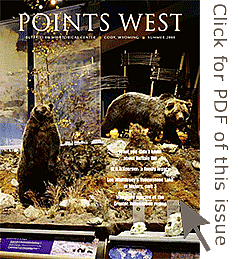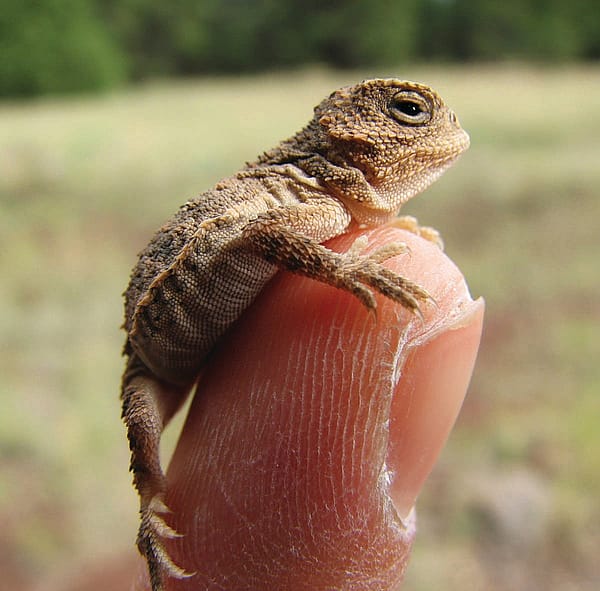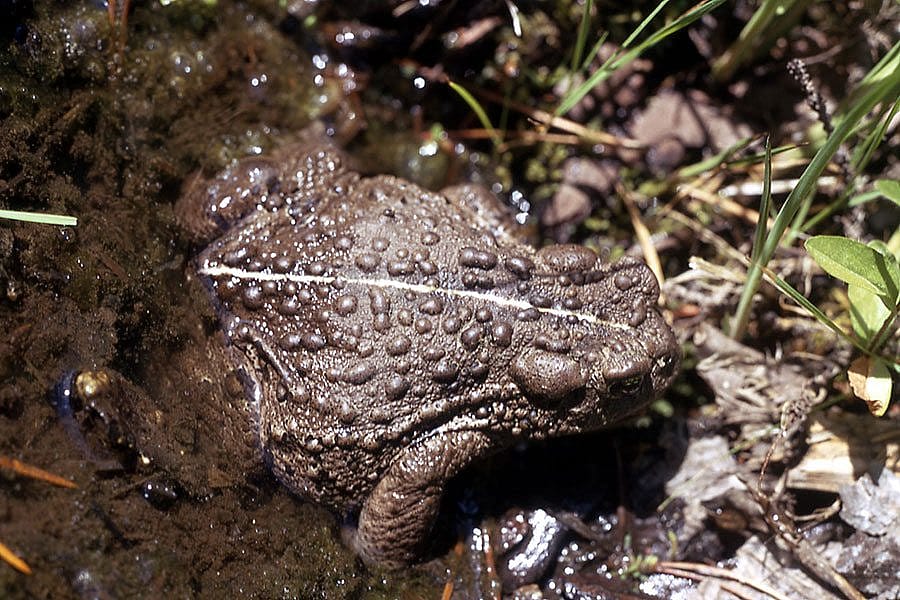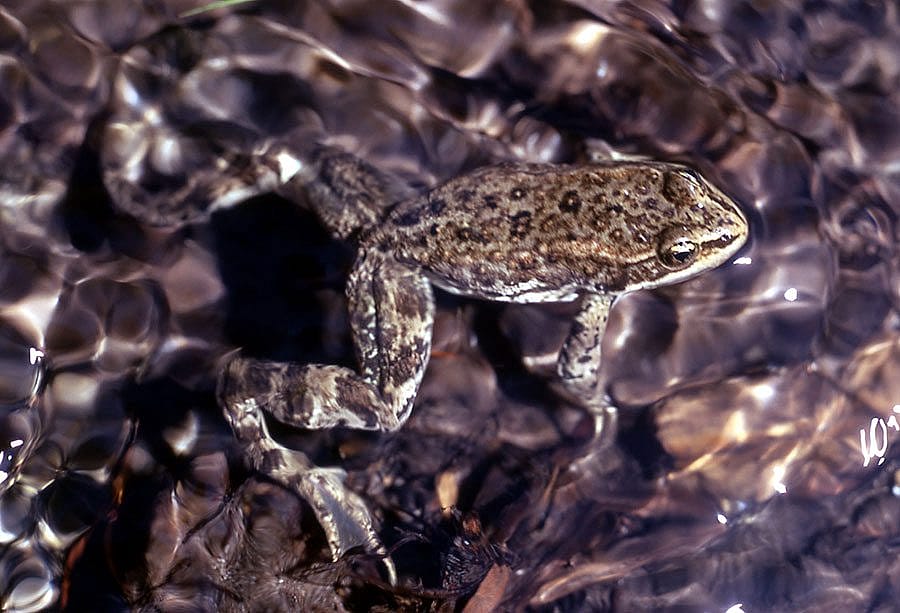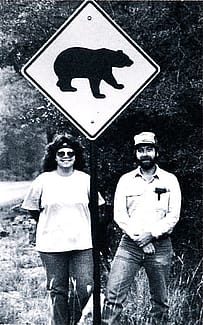
Lizards, turtles, and amphibians of the Greater Yellowstone region – Points West Online
Originally published in Points West magazine
Summer 2008
Hopalong Species: Lizards, turtles, and amphibians of the Greater Yellowstone region
By Philip and Susan McClinton
All for the love of research
Inch forward… That’s it—just a little bit more. Move forward again painfully, slowly over gravel terrain, gouging hands, elbows, and knees. Reposition; maintain eye contact with the intended lizard. Shift position slightly; repeat the inching forward like a worm.
Holding a “snare” stick (which has a loop of fishing line that can be quickly tightened) in one hand and a cloth bag in the other, my wife Susan and I stalked a sagebrush lizard—the goal to capture and compare it with other sagebrush lizards from different locales.
Finally in position, the trick now was to inch the snare forward to slip the noose around the lizard’s neck. Slowly, very slowly, the snare moved forward, the final move executed with lightening speed so the lizard couldn’t skitter away. But true to its nature, this particular lizard had other ideas and managed to slip the noose before it could be tightened.
We had no choice but to start the capture ritual all over again—repeated four times before the lizard was actually caught. In the end, the wary subject provided us with measurements to compare to other lizard specimens, and its image was captured to compare coloration. After gathering all the information we needed, we set the lizard free, and in characteristic form, it dashed for the nearest rock crevice to hide from its human tormentors.
Oops! Dropped a tail
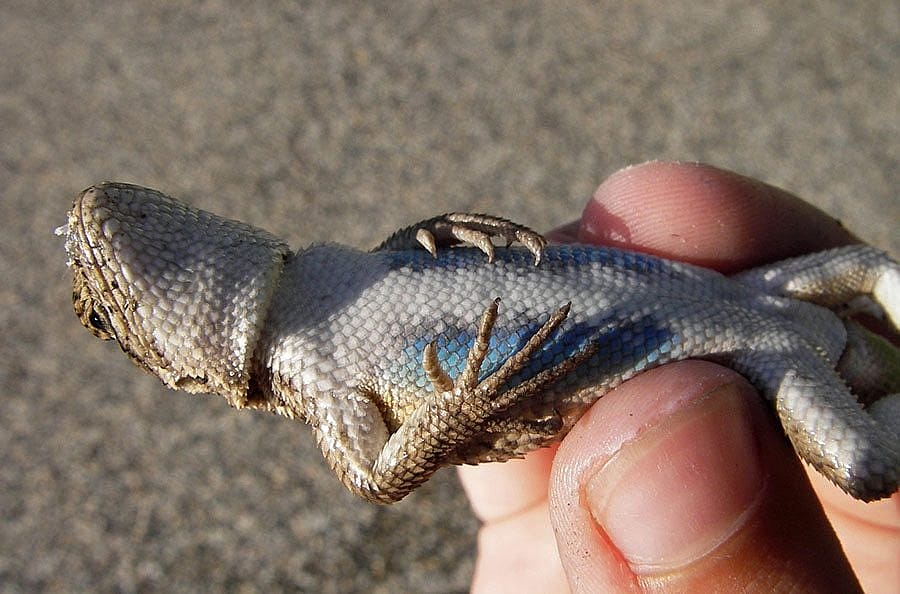
Lizards are reptiles of the order Squamata (suborder Sauria or Lacertilia), which they share with snakes (Ophidians). There are huge variations in size, color, and appearance among the forty classification families of lizards. They are usually four-legged, with external ear openings, movable eyelids, and a long tail. Their bodies are covered with either rough or smooth tubercular (bony bumps or projections) scales, properly called osteoderms. These bumps are made of keratin—the same material as human fingernails and hair—and are formed by the epidermis, the outer skin covering.
Lizard species range in adult length from a few centimeters like the Caribbean geckos, to nearly three meters, the size of the Komodo dragons. Only two species of lizards are poisonous: the Gila monster found in Arizona and Mexico and the beaded lizard from Mexico. Most lizards are oviparous—that is, egg layers—though a few species are viviparous, which means they bear live young.
Two lizards occur in the Greater Yellowstone region: the northern sagebrush lizard or Sceloporus graciosus graciosus, and the greater short-horned lizard Phrynosoma hernandesi hernandesi. As with snakes found in the same area, little is known about their population numbers, but it is certain that the cool, dry conditions limit population size.
The northern sagebrush lizard is most frequently seen in rocky areas and can be found in the thermal areas of Yellowstone National Park, sometimes at elevations exceeding 8,000 feet.
Maximum size for this colorful lizard is usually less than five inches with males slightly larger than females. Males have bright blue patches on the belly and on each side, with blue mottling on the throat. An interesting and laughable aspect of their mating behavior is that, during the breeding season, males do push-ups on elevated perches to display their bright blue side patches to attract females and warn off other males. Breeding occurs during the summer months, and the female may lay two clutches of three to five eggs yearly.
Some of this species are capable of dropping their tail to save their neck. These “throwaway” tails will soon grow back in a similar configuration as the original tail. New bones don’t develop to replace lost ones but new cartilage is developed, and there may also be a slight difference in the pattern of scales and coloration.
This action is called autotomy and is a defensive technique that can help keep a lizard alive as it distracts their predators with just enough time to escape. The tail has its own nervous system, and may also continue to move independently, further distracting the predator.
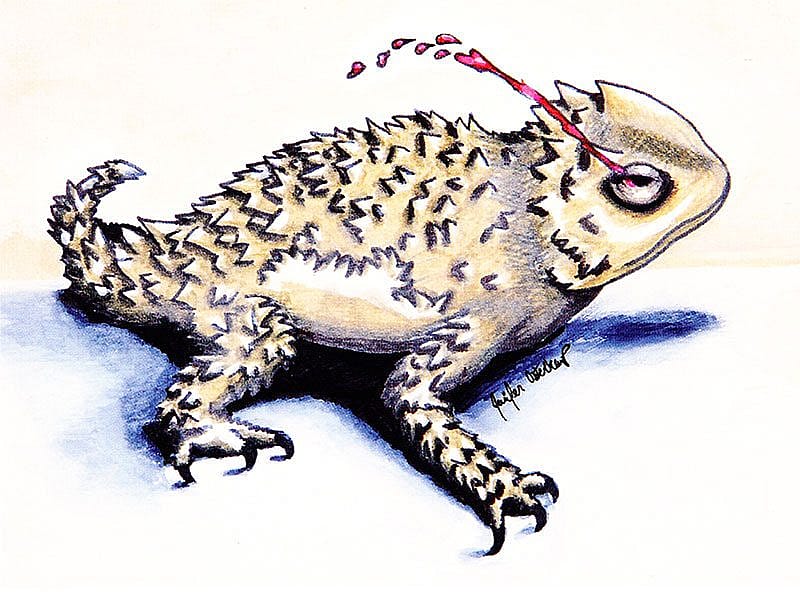
Here’s blood in your eye
The “horny toad” or greater short-horned lizard is often difficult to find because it is usually solitary and “freezes” when approached, exhibiting a “now you see me; now you don’t” behavior. They can be found by walking outward in a spiral pattern from ant nests which provide them with their favorite food. It is relatively easy to capture these lizards because camouflage, not speed, is their forte.” They are also scaly to the touch and exhibit a “fringe” of horns encircling the back of the head as well as a fringe of scales on each side of the body and coloration closely resembling their habitat.
Most horned lizard species are well represented in the fossil record of the Pleistocene era, one million years ago. Humans and horned lizards have shared each other’s company for thousands of years. This relationship is recorded from numerous cultures in art and ceremony, the latter because they’re considered symbols of strength.
The greater short-horned lizard is more cold tolerant than other species of horned lizard. They are relatively small and may inflate themselves by gulping air and jabbing with their “horns” to discourage predators. Some species can even spurt blood from the eyes, having a repellant effect on predators, especially canids like coyotes and foxes. These horned lizards aim for the eyes of the predator, and the blood may be so chemically irritating it discourages predators from further pursuit.
Greater short-horned lizards have often been kept as pets but rarely survive captivity because of their need to have large numbers of live ants available. They are viviparous while other species of horned lizard are oviparous. Five to thirty-six young are born in mid to late summer.
Hodgepodge populations
Five other species of reptile also occur infrequently, if at all, in the Greater Yellowstone region: western painted turtle (Chrysemys picta belli), western spiny soft-shelled turtle (Apalone spinifera hartwegi), common snapping turtle (Chelydra serpentina), red-sided garter snake (Thamnophis sirtalis parietalis), eastern yellow-bellied racer (Coluber constrictor flaviventris) and western yellow-bellied racer (Coluber constrictor mormon). Specimen collections are scant, but many of the reptiles in the Greater Yellowstone region have only recently become subjects of intensive research and field collection. Certainly the recent discovery that the black-headed snake (Tantilla nigriceps) is more widespread in Wyoming than otherwise thought is encouragement for both professional and amateur herpetologists.
Hopalong species
Only four species of amphibians inhabit the Greater Yellowstone region: boreal toad, western chorus frog, spotted frog, and tiger salamander. Very little is known about these amphibians not only in the state of Wyoming, but in the Greater Yellowstone region in general. Amphibians generally prefer warm, moist conditions, and the past glacial activity in the area and dry cool climate may account for their infrequent occurrence.
Amphibians are “…a cold-blooded, smooth-skinned vertebrate of the Class Amphibia, such as a frog or salamander, that characteristically hatches from eggs as an aquatic larva with gills. The larva then transforms into an adult with air-breathing lungs…an animal capable of living both on land and in water.” Egg-laying takes place in water. Worldwide, there are more than 5,500 species described; 276 species of amphibians are found in the continental United States and only 39 species in Wyoming.
The Greater Yellowstone region’s lone toad
The boreal toad (Bufo boreas boreas) is the area’s only toad, and adults can be almost four inches in length. They are stocky with a blunt nose and are identified by the lack of a prominent cranial crest and horizontal rather than vertical pupils. It is an old fable that handling toads will lead to warts, but they do defend themselves by secreting an irritating fluid, as do many toads, from glands behind their eyes and on their backs.
Boreal toads are found in moist environments at both low and high elevation. Juveniles tend to be diurnal (active during the day) while adults are generally nocturnal(active at night) except in the spring.
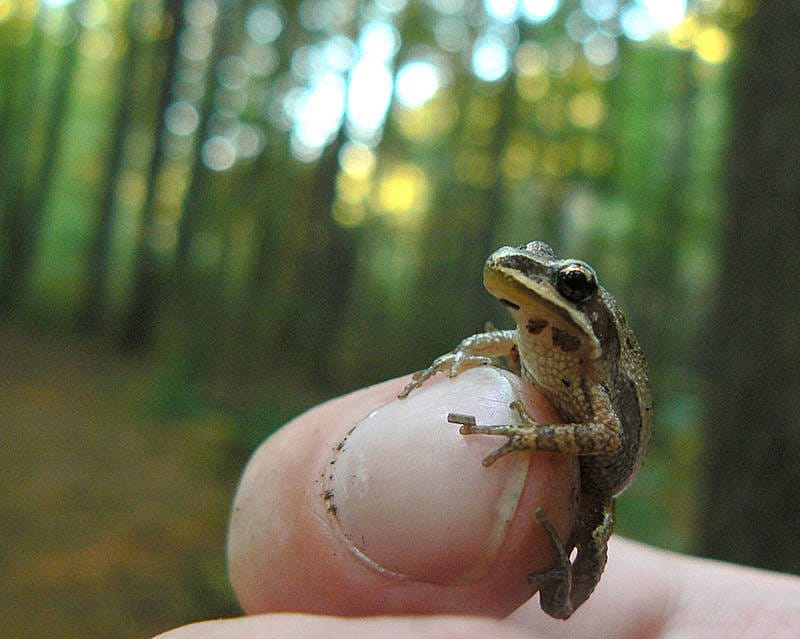
Their reproductive behavior is poorly known, but boreal toads are egg layers, and tiny boreal toad tadpoles hatch from the gelatinous strings of eggs that are laid in warm water during the early summer. Typical clutches may contain as many as 12,000 eggs. These black tadpoles usually group together for security and protection from predators. Large aggregations of these tadpoles are often found, and one aggregation in Yellowstone National Park was measured at about 20 inches wide by almost 117 feet long. Tadpoles metamorphose (transform) into toadlets during the first summer and usually winter in the area where they were deposited as eggs.
A chorus of frogs
Western chorus frogs (Pseudacris triseriata) are seldom seen due to their secretive habits and their small size. However, they’re most often heard producing a continuous “chorus” at breeding sites of shallow, intermittent ponds or pools during the late spring. Their call is similar to the sound produced when someone runs his thumb along the edge of a comb.
Chorus frogs occupy habitat in mesic (moist) forests and meadows near riparian sites. As with the boreal toad, very little is actually known about the reproductive behavior of chorus frogs. They lay eggs in clusters of 20 – 100, and they are attached to submerged vegetation. Eggs hatch in about two weeks, and tadpoles transform into adults in about eight weeks.
In winter, they hibernate under leaves, logs, or under thick grass in meadows. There are anecdotal reports of them freezing solid in the winter in Manitoba, Canada, with no harmful effects. Chorus frogs are one of the first amphibians to emerge after winter, often seen while snow and ice are still present.
It’s good to be popular
The Columbia spotted frog (Rana luteiventris) is the best known and most abundant amphibian in the Greater Yellowstone region. They’re regularly found at the edge of water sources and in or near forest openings. Wetlands near or at tree line are also used, but populations are uncommon in large, open meadows.
Spotted frogs breed during the early summer depending on temperature. Eggs are laid in quiet or even stagnant water in gelatinous masses. Many times all the egg masses of the population are in the same location in the water source, and in permanent ponds, tadpoles may not change to adult frogs until their second year of life. Adults and young frogs often disperse into marsh and forest habitats, but are not usually found far from open water.
There’s charisma going on here
Possibly the most charismatic amphibian in the Greater Yellowstone region is the blotched tiger salamander (Ambystoma mavortium melanostictum). This is the only salamander native to this region, and is the second largest salamander in the United States, reaching a length of up to nine inches including the tail.
Blotched tiger salamanders are widespread in the Greater Yellowstone region with no specific habitat preferences other than a penchant for moist environments. Adults spend most of their time burrowing under logs, rocks, and underground. They emerge on rainy nights (typically after a heavy rain) to migrate to their breeding ponds.
Tiger salamanders are terrestrial as adults and return to the water to breed. Females are nudged by males to precipitate the breeding process and after a water-ballet of courtship, the male deposits a spermatophore (sperm packet) onto the bottom of the watery substrate. The female picks up the spermatophore and, within her body, the packet dissolves. She then deposits the fertilized eggs in two or three groups on vegetation at the water’s edge. There are reports of females laying up to 1,000 eggs.
Normal incubation takes place in two to three weeks, but the timing depends on the water temperature, and development is accelerated in warmer temperatures. After the breeding migration, adults return to their moist homes in the underground substrate. They enter hibernation in the fall and emerge in early summer depending on elevation.
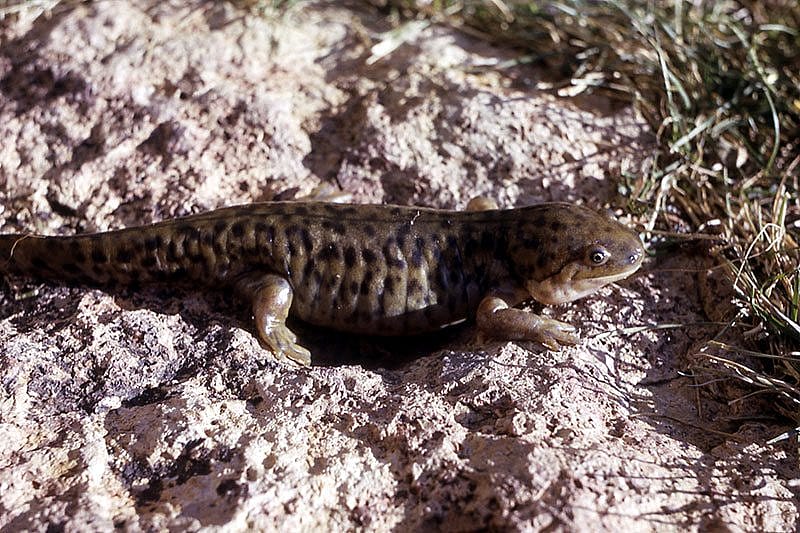
The larvae have large feathery gills behind the ears and were once commonly referred to as “water dogs” or “mud puppies.” Sometimes the larvae do not develop into adults but instead retain the feathery gills, a condition known as neotenic. These “neotenes” become sexually mature while in their larval form, and this is especially common when terrestrial conditions are inferior. When an over-abundance of larvae are present, they may resort to cannibalism.
Some researchers have abandoned the recognition of subspecies of the old classification Ambystoma tigrinum due to new information on genetic variations in the species, which may not support the traditionally recognized subspecies. That is, interbreeding between sub-species may actually change how they’re scientifically identified.
Biological Cassandras
Amphibian populations are declining not only in the Greater Yellowstone region but also around the world. A survey by the Washington Post in 2004 found that 32 percent of all amphibian species worldwide face extinction. As many as 122 species have disappeared since 1980, and an additional 1,900 are in danger of becoming extinct. They are, in a sense, the “canary in the coal mine” species. That is, their survival—or lack thereof—may warn us of impending crises in our ecosystems.
There are many speculations as to the cause of the decline in amphibian numbers. Amphibians are extremely sensitive to habitat degradation, loss, disturbance, and fragmentation since their very livelihood depends on the presence of water for breeding purposes. Other factors that may affect amphibians are pollution, disease, predation by imported “exotic” species, and drought.
Without a doubt, well-structured scientific study is needed to determine the actual cause of their decline within the Greater Yellowstone region. Nigel Williams, in an article written for Science Week in 2004, stated that, “A new first-ever global study estimates that one third of the world’s amphibian species are in danger of extinction. Researchers think that the mysterious collapse in numbers might be a warning that our environment may be in a worse state than we previously thought since amphibians, more than any other animals, are known to be the most vulnerable to subtle changes in their ecosystems.”
J.M. Kiesecker et. al. drew similar conclusions in their 2004 study of how amphibian decline is affecting disease prevalence among humans and wildlife, stating, “The link is suggestive, not proven, but there are compelling similarities between recent disease outbreaks in many animals. Amphibians have been hit particularly hard because of their life cycle and physiology. Frogs and salamanders are exquisitely sensitive to environmental changes. This property casts them in the role of biological Cassandras, prophesying a pessimistic message of environmental degradation that we don’t want to hear. Like Homer’s Trojans, we’ve mostly ignored their warnings.”
Hopping along to the future
Hopalong species add to the charming mystique the Greater Yellowstone region offers visitors. Chorus frogs lull us to sleep with their nightly song…one of many “wild” songs abundant in the area. Children and adults alike delight in spotting lizards—what might be called “living mini-dinosaurs.” For the fortunate few, blotched tiger salamanders amaze with their ability to migrate mysteriously to water for breeding. Anyone who has ever watched one of these creatures can’t help but smile at their odd waddling side-to-side gait and marvel at their ability to navigate to just the right spot to breed. It remains in our hands to research, conserve, and protect for future generations, not only these amazing little hopalong species, but all the animals that add to the richness and splendid diversity of the Greater Yellowstone region.
About the authors
Philip L. McClinton is the former curatorial assistant for the Draper Natural History Museum. Susan F. McClinton served as the information and education specialist on grizzly bears for the Shoshone National Forest in Cody, Wyoming, during the summer of 2005. Each holds a master’s degree in biology from Sul Ross State University in Alpine, Texas, and both have a keen interest in animal behavior, conservation, and wildlife education—especially that which takes place in the natural environment. Both McClintons have conducted extensive research on black bears; mountain lions; white-winged, mourning, and Inca doves; and parasite/host interactions in nature. The McClintons have published and presented a number of articles and reports about their work.
Post 057
Written By
Nancy McClure
Nancy now does Grants & Foundations Relations for the Center of the West's Development Department, but was formerly the Content Producer for the Center's Public Relations Department, where her work included writing and updating website content, publicizing events, copy editing, working with images, and producing the e-newsletter Western Wire. Her current job is seeking and applying for funding from government grants and private foundations. In her spare time, Nancy enjoys photography, reading, flower gardening, and playing the flute.
